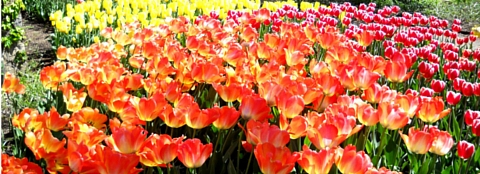April Northern Garden Checklist

Garden Cleanup:
It’s time to get busy cleaning up your garden. Remove and compost any stems and seedpods left standing for winter.
- Divide overgrown and floppy summer and fall blooming perennials as shoots emerge.
- Mark the location of late emerging perennials like butterfly weed and hardy hibiscus to avoid damaging or accidentally weeding them out.
- Remove mulch from strawberries, tender perennials and bulbs as temperatures hover around freezing or when the covered plants begin to grow.
Garden Preparation:
- Take a soil test as soon as the snow melts and soil thaws. The results will help you use the right type and amount of fertilizer for the plants you are growing. Contact your local Extension service for soil testing information.
- Start a new garden or prepare existing gardens as soon as the soil can be worked. Incorporate organic matter such as compost into the top 8 to 12 inches of soil to improve drainage in clay soil and moisture retention in sandy soil.
- Incorporate a low nitrogen slow release fertilizer like Milorganite® into the soil prior to planting and to established bulb and perennial gardens as shoots emerge. This will provide the nutrients your plants need for the first few months of the growing season.
- Spread several inches of compost over the soil surface of existing perennial gardens. Lightly rake the compost into the soil surface. Apply organic matter every two or three years to keep your perennials vigorous.
Planting Outdoors:
- Plant pansies, dusty miller, snapdragons and other cool season annuals outdoors. These hardy annuals can tolerate the cooler temperatures of early spring.
- Plant field grown or bare root trees, shrubs and perennials as soon as plants are available. Continue planting balled-and-burlapped and container plants throughout the growing season.
- Transplant trees and shrubs when the ground has thawed and before growth begins.
- Plant asparagus roots in mid spring. Amend the top 12 inches of soil with compost or aged manure. Set the asparagus roots 12 inches apart in trenches 6 inches deep and rows 36 inches apart.
- Plant seeds of cool season crops like beets, carrots, radishes, turnips, leaf lettuce, spinach, mustard greens, onion sets, peas and potatoes outdoors in properly prepared soil.
Garden Harvest:
- Harvest established asparagus plantings when spears are 6 to 8 inches long. Harvest four-year and older plants for a total of six to eight weeks.
- Harvest established rhubarb plants for eight to ten weeks. Pull or cut the leafstalks from the plant when 12 to 15 inches tall, thick and crisp. Remove the leaf (its toxic) and only use the stalk.

